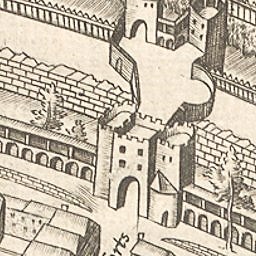Hahnentorburg
The Hahnentorburg is one of originally twelve gate castles in the eight kilometer long medieval city wall of Cologne (1180-1220) and secured the western access to the city on the road to Aachen and Jülich . It is located on today's Rudolfplatz .
History of origin
The gate was built as a double tower gate at the beginning of the 13th century and was first mentioned in 1264. Similar to this type of gate are the still existing Eigelsteintor in the north of the city wall and the demolished Gereonstor in the northwest.
By Hahnentor entered the Middle Ages the Kings on their coronation - ceremony in Aachen , the city on the Aachener Strasse and moved to the Shrine of the Three Kings in Cologne Cathedral . The Torburg was used as a prison , among others for the traveling preacher Adolf Clarenbach and the draftsman, lithographer, publisher and counterfeiter Jodocus Schlappal .
The name of the large gate is possibly derived from "Hageno von Anselm", an earlier landowner of the same name from the 12th century, after whom it was first Hanenporcen and then Hagenenporcen . According to other sources, the derivation goes back to Hano (" grove "), ie "wooden gate" or "wooden gate" because of the forest areas along the road leading to Aachen outside the city wall . In the Cologne cityscape of 1570 by Arnold Mercator it was called "Hanenpforts", the street leading through it was "Hanen straiss" (today's Hahnenstraße ). On the Tranchot map from 1808, this gate was called Porte du Coq ("Hahnentor"). When the street was renamed after the decision of December 16, 1812, it was named Port des Coqs or "Hahnen-Pforte".
On May 18, 1877, the first line of the Cologne horse-drawn railway was opened at Hahnentor . The City Council of Cologne decided on February 26, 1881 to acquire the area of the city wall and the associated military area, and on February 28, 1881, the Lord Mayor Hermann Becker signed the purchase contract for the acquisition of the fortress site. On May 5, 1881, the purchase contract between the City of Cologne and the War Ministry (military treasury) became legally effective through confirmation by Reich Chancellor Otto von Bismarck , through which the city acquired the area of 122.5 hectares for a purchase price of 11.74 million marks. On November 4th, 1881 the Prussian military treasury handed over the middle third of the fortress paleon from Weyertor to Gereonstor to the city administration. Only on June 5, 1883, the part from Weyertor to the Rhine became municipal property, on July 5, 1895 the rest of the Gereonstor followed north to the Rhine. The demolition work on the medieval city wall began on June 11, 1881 at the level of the Gereon Gate . The city administration had made a conscious decision to integrate only four gate castles into the new urban development concept, namely Hahnentor, Severinstorburg , Eigelsteintorburg , the rest of the Ulrepforte and four short sections of the wall at Bottmühle , Severinstor, Hansaplatz, Sachsenring and Bayenturm .
The west adjoining the Hahnentor place called 1882 since May 4 Hahnentorplatz , a year later, he was in on 20 December 1883 Rudolfplatz renamed. Like the Eigelsteintorburg, the Hahnentorburg was restored by the city architect Josef Stübben around 1890 (inscription under the eagle coat of arms on the field side: Renewed 1888) and set up as a historical museum, the predecessor of the city museum. Replicas of medieval throwing machines were set up on the tower roofs so that they can be seen from afar.
The Hahnentorburg was badly damaged in World War II. The half tower on the left from the field side was largely destroyed. The gate later served as an exhibition building for the professional association of visual artists . Since 1988 it has been home to the EhrenGarde Carnival Society of the City of Cologne 1902 and a casino that can be rented.
In addition to the Hahnentorburg, other archways have been preserved. The Severinstorburg , the Ulrepforte and the Eigelsteintorburg , along with the Saxon Tower, are well-preserved evidence of the extensively used city fortifications of Cologne.
literature
- Axel Schwarz, Marcus Leifeld (ed.): The Hahnentorburg. From the medieval city gate to the domicile of the Honor Guard of the City of Cologne 1902 eV , Cologne 2008. ISBN 978-3-00-024835-1 .
Web links
- Article about the Hahnentorburg at Monumente Online
Individual evidence
- ↑ Cologne History Association, Yearbook , Volume 22, p. 75
- ↑ Peter Fuchs (Ed.), Chronicle of the History of the City of Cologne , Volume 2, 1991, p. 157
- ↑ Fred Kaufmann / Dagmar Lutz / Gudrun Schmidt-Esters, Cologne street names: Neustadt and Deutz , 1996, p. 11
- ↑ Werner Schäfke, The Rhine from Mainz to Kšln: a journey through the romantic Rhine Valley , p. 225
Coordinates: 50 ° 56 ′ 11.2 ″ N , 6 ° 56 ′ 24.6 ″ E






